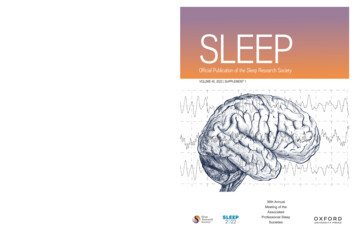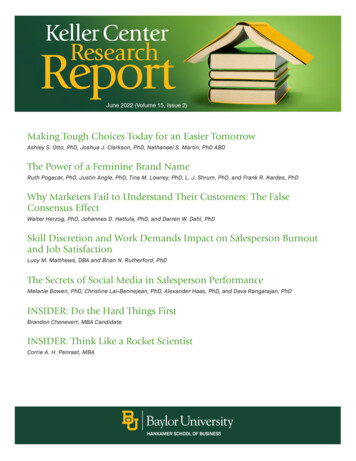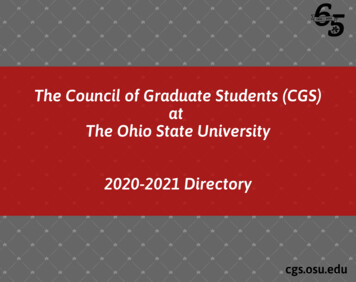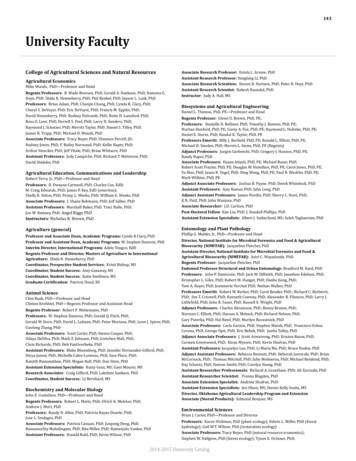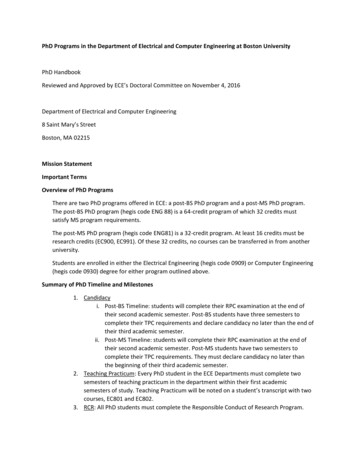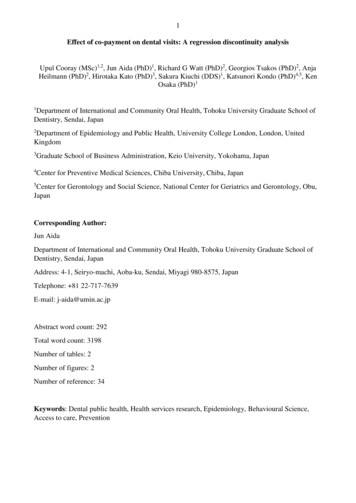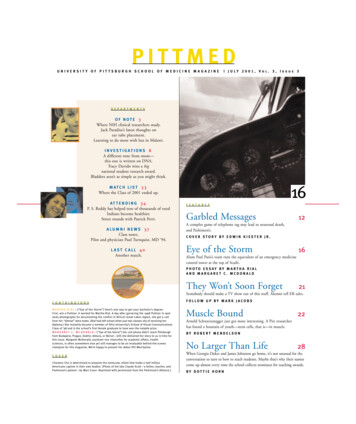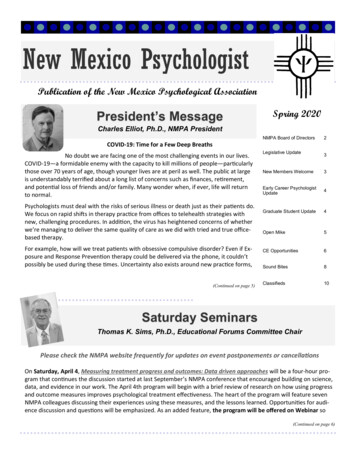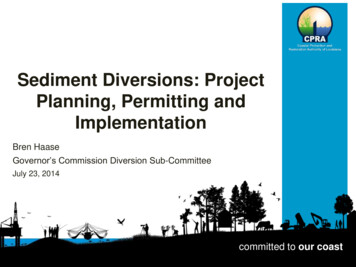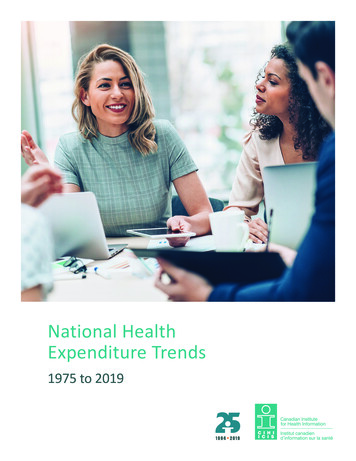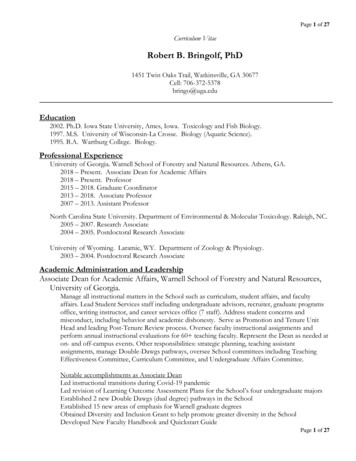
Transcription
Page 1 of 27Curriculum VitaeRobert B. Bringolf, PhD1451 Twin Oaks Trail, Watkinsville, GA 30677Cell: 706-372-5378bringo@uga.eduEducation2002. Ph.D. Iowa State University, Ames, Iowa. Toxicology and Fish Biology.1997. M.S. University of Wisconsin-La Crosse. Biology (Aquatic Science).1995. B.A. Wartburg College. Biology.Professional ExperienceUniversity of Georgia. Warnell School of Forestry and Natural Resources. Athens, GA.2018 – Present. Associate Dean for Academic Affairs2018 – Present. Professor2015 – 2018. Graduate Coordinator2013 – 2018. Associate Professor2007 – 2013. Assistant ProfessorNorth Carolina State University. Department of Environmental & Molecular Toxicology. Raleigh, NC.2005 – 2007. Research Associate2004 – 2005. Postdoctoral Research AssociateUniversity of Wyoming. Laramie, WY. Department of Zoology & Physiology.2003 – 2004. Postdoctoral Research AssociateAcademic Administration and LeadershipAssociate Dean for Academic Affairs, Warnell School of Forestry and Natural Resources,University of Georgia.Manage all instructional matters in the School such as curriculum, student affairs, and facultyaffairs. Lead Student Services staff including undergraduate advisors, recruiter, graduate programsoffice, writing instructor, and career services office (7 staff). Address student concerns andmisconduct, including behavior and academic dishonesty. Serve as Promotion and Tenure UnitHead and leading Post-Tenure Review process. Oversee faculty instructional assignments andperform annual instructional evaluations for 60 teaching faculty. Represent the Dean as needed aton- and off-campus events. Other responsibilities: strategic planning, teaching assistantassignments, manage Double-Dawgs pathways, oversee School committees including TeachingEffectiveness Committee, Curriculum Committee, and Undergraduate Affairs Committee.Notable accomplishments as Associate DeanLed instructional transitions during Covid-19 pandemicLed revision of Learning Outcome Assessment Plans for the School’s four undergraduate majorsEstablished 2 new Double Dawgs (dual degree) pathways in the SchoolEstablished 15 new areas of emphasis for Warnell graduate degreesObtained Diversity and Inclusion Grant to help promote greater diversity in the SchoolDeveloped New Faculty Handbook and Quickstart GuidePage 1 of 27
Page 2 of 27Academic Leadership DevelopmentCertificate in Diversity and Inclusion. UGA. In progress.High Impact Leadership: Essentials. UGA. Feb. 25 – April 1, 2020.University System of Georgia Professional Fundraising for Deans and Academic Leaders. Mar 2020Faculty Performance Evaluations and Mentoring. UGA. Jan. 2020Strategic Planning workshop series. UGA. Fall 2019Team Development. UGA. Oct. 2019Summer Leadership Institute. UGA. July 2019Faculty Affairs Symposium. UGA. July 2019Training for new Department Heads and Associate Deans. UGA. Sept. 2018.Graduate Coordinator, Warnell School of Forestry and Natural Resources, University ofGeorgia.Served as point of contact and liaison for approx. 200 graduate students, communicating GraduateSchool policies to students and faculty as well as shepherding necessary appeals. Providedmentoring support for students and advisors. Chaired the Graduate Affairs Committee, whichhandles graduate matters such as appeals and rankings for consideration of School assistantships.Teaching ExperienceUniversity of GeorgiaProfessional Development and CommunicationFirst Year Odyssey Seminar: Science of FishingFundamentals of EcotoxicologyFish Physiology & LabSustainable AquacultureEcotoxicologyGraduate Seminar: EcotoxicologyTeaching PracticumScientific Research in Fors. & Nat. Res.Senior ProjectFirst Year Odyssey Seminar: AquaponicsFirst Year Odyssey Seminar: Fish BiologyBiology & Ecology of Freshwater MusselsEnvironmental Biology of FishesNatural Resources ConservationFANR 3950FYOS 1001FISH 8350FISH 4500/6500FISH 4550/6550FISH 4600/6600FISH 8300FANR 7990/9900FANR 8200FANR 4500FYOS 1001FYOS 1001WILD 8300FISH 4300/6300FANR 1100Fall 2019, 2020Fall 2019Spring 2010, Summer 2017-presentFall 2008, 2012-2018Spring 2010-2018Spring 2010-2016 (even yrs)Summer 2015, 2016Fall 2013Spring 2014Spring 2013Fall 2013Fall 2011, 2012Spring 2008, 2012Fall 2009-2011Spring 2009University of WyomingEcotoxicologyIchthyologyFish Culture and NutritionZOO 5790ZOO 4330/5330ZOO 4740/5740Spring 2004Spring 2003Fall 2003Invited LecturesEcotoxicology. Fish Physiology (FISH 4500), UGA. Nov. 2019.Exploring graduate school. Professional Development and Communication (FANR 3950), University ofGeorgia, Athens, GA. Nov. 2017, April 2018.Gender-bending fish: Intersex and beyond. Orientation to Environmental Health Science (EHSC 2020),University of Georgia, Athens, GA. March 2014, Oct 2015, Nov. 2016.Introduction to Ecotoxicology. Physiological Ecology (ECOL 4240), University of Georgia, Athens, GA.September, 2013, 2014, 2015, 2016, 2017, 2018.Endocrine Disruption. Honors Gateway Seminar (HONS 3070H). University of Georgia, Athens, GA.Page 2 of 27
Page 3 of 27October 2009, 2010, 2012, 2013, April 2011.Emerging Contaminants. Chemical Toxicology (PHRM 8930), University of Georgia, Athens, GA. March2011, 2012.Water Pollution. Natural Resource Conservation (FORS 1100), University of Georgia, Athens, GA.September 2008, 2009, 2010, 2012, 2013, 2014.Introduction to Ecotoxicology. Introduction to Toxicology (PHRM 6910), University of Georgia, Athens,GA. December, 2010, 2011, 2012, 2013, 2014, 2015.Endocrine Disruption in Fish (Lab). Aquatic Toxicology (EHSC 8310), University of Georgia, Athens, GA.April 2010, 2012.Endocrine Disruption. Seminar in Modern Biology (BIOL 2990H). University of Georgia, Athens, GA.October 2008, 2009, 2013, 2014.Fish Reproductive Physiology & Endocrine Disruption. Fish Physiology (FORS 4370), University of Georgia,Athens, GA, December 3, 2007.Mussels on Prozac: Happy as Clams? Environmental Toxicology and Chemistry (TOX 414), North CarolinaState University, Raleigh, NC, September 20, 2006.Endocrine Disruption. Principles of Toxicology (TOX 501), Iowa State University, Ames, IA, April 2, 2002.Endocrine disrupters in the environment. Pesticides in the Environment (TOX 513), Iowa State University,Ames, IA, April 12, 2001.Student MentoringGraduate Student Committees Chaired (all University of Georgia unless otherwise noted)StudentThomas BlissBrittany Jensen Cher Nicholson David Haskins Kyle Brown Shannon KirkAlex PelletierMatthew UrichAdrian ParrDavid Haskins Matthew Hamilton Jace NelsonElizabeth HinckerRebecca PhilipsWhitney JacobsAndrea FrittsPeter HazeltonKristen KellockRussell Parr Joshua SeehornJennifer DPhDPhDMSMNRMSYearSpring 2024fall 2022fall 2022fall loymentin progressin progressin progressin progressBiologist, Florida Fish & Wildlife CommissionBiologist, Florida State University Shellfish HatcheryPhD student, University of SaskatchewanToxicologist, US EPAPostdoc, Univ. of MinnesotaPhD student, University of GeorgiaBiological Technician, SRELBiologist, VA Dept. of Game and FishAquarist Assistant, National Aquarium (Baltimore, MD)Fisheries Biologist, US Fish and Wildlife ServiceAttorney, Balch & Bingham LLPResearch Fish Biologist, US Fish & Wildlife ServiceChief, Natural Heritage Program, MA Div. of Fish & WildlifeResearch Scientist, MN Dept. of HealthProject Manager, Resource Land ConsultantsOwner, US Ecosystems, LLC.Fisheries Biologist, MI Dept. of Env. Quality Co-chair*Warnell School of Forestry & Natural Resources**UGA Interdisciplinary Toxicology Program***UGA Savannah River Ecology Lab (Warnell graduates)Graduate Student Committee Member (all University of Georgia unless otherwise noted)StudentNatalie PerkinsLauren CarrollKristen ZemaitisDegreeMSMSMSYearIn ProgressIn ProgressIn ProgressProgramCollege of AgricultureWarnellOdum School of EcologyPage 3 of 27
Page 4 of 27Jeff CullenPhDIn ProgressMichael BakerMSIn ProgressBrendan DulaMSIn ProgressTabitha PhillipsPhDIn ProgressTalia LevineMSIn ProgressLindsey DanielMS2020Nathaniel HancockMS2019Guy ErohMS2019Adam FoxPhD2018Alex CummingsMS2018Tabitha PhillipsMS2018Melissa MartinMS2018Tim ClohisyMNR 2017Donna GlinskiPhD2017Jessica DavisMS2017Ramya KoliPhD2017Zoe CooperMS2017Garron BrandonMNR 2016Andrew MarburyMS2016Samuel FureyMNR 2016Qi LuoPhD2015Cassie JanschMS2015Derek BahrMS2015Katie BockrathPhD2015Eric MyersMS2015Caitlin RumrillMS2015Mark MyerMS2015Sean SterrettPhD2014Kristi SegalPhD2014Joseph IburgPhD2014Rashmi SinghPhD2013Gabrielle Robinson MS2013Gary EddyMNR 2013Emily RobertsPhD2013Chi-Yen TsengMS2013Jamie MorganMS2013Phong NguyenMS2013Michael BednarskiPhD2012Zach AnglinMS2012Justin DycusMS2011Mark FrittsMS2011Hayden MartinMS2010Daniel FarraeMS2010Suzanne BairdMS2009Allison PriceMS2008*Warnell School of Forestry & Natural Resources**College of Public Health***Savannah River Ecology LabWarnellWarnellWarnellWarnellOdum School of EcologyCollege of Veterinary Medicine (non-thesis llInterdisciplinary Toxicology ProgramOdum School of EcologyInterdisciplinary Toxicology ry Toxicology ProgramWarnellWarnellGeneticsCollege of EngineeringOdum School of Ecology/SREL***Env. Health Science, CPHWarnellOdum School of EcologyInterdisciplinary Toxicology ProgramInterdiciplinary Toxicology ProgramWarnellWarnellInterdisciplinary Toxicology ProgramInterdisciplinary Toxicology arnellWarnellEnv. Health Science, CPH**Warnell*Undergraduate Research Advisor (all University of Georgia unless otherwise noted)StudentErika KlarMorgan ManningBrenna SchroderAustin HaneyDerek PopeChris TuckerCody RewisDegreeSr. ThesisSr. ThesisSr. ThesisSr. ThesisSr. ThesisSr. ThesisDirected StudyYearIn progressSpring 2019Fall 2017Fall 2016Fall 2016Spring 2016Spring ellWarnellPage 4 of 27
Page 5 of 27Regan DurkinDirected Study Spring 2016UGA Terry College of BusinessLaura RascheCUROFall 2014UGA BiologyAaron HartDirected Study Fall 2013UGA Plant SciencesGeorge FullertonSr. ThesisFall 2013WarnellDaniel ThomasSr. ThesisSpring 2013WarnellZach DeWolfeSr. ThesisSpring 2013WarnellDiana Ji-Hae SongCUROSummer 2012UGA BiologyJulie CreamerSr. ThesisSpring 2012WarnellAriana KazezCUROSummer 2011UGA BiologyElizabeth PruittCUROSummer 2011UGA BiologyEmily ReedHonors Thesis Fall 2010WarnellRyan HarrellSr. ThesisFall 2010WarnellEthan ShinebaumCUROSummers 2010, 2011UGA BiologyRussell ParrSr. ThesisFall 2008WarnellPeer-Reviewed Publications Underlined authors indicate graduate students under the direction ofR. Bringolf.Career TotalsPublicationsPresentationsJournal articlesBook chaptersResearch NoteTotalInvited SymposiaContributedInvited SeminarsTotalPublished/In press5411561710222141Submitted/In Review254)Haskins, D.L., M.K. Brown, R.B. Bringolf, and T. Tuberville. Brown watersnakes (Nerodiataxispilota) as bioindicators of mercury contamination in riverine systems. Science of the TotalEnvironment. In Press.53)Urich, M.L., W.M. Henderson, A.H. MacLeod, L.T. Yonkos, and R.B. Bringolf. 2020. Gonadmetabolomics and blood biochemical analysis reveal differences associated with testicular oocytes inwild largemouth bass (Micropterus salmoides). Comparative Biochemistry and Physiology, Part B. InPress.52)Jennings, C.J., M.S. Allen, C. Belcher, R.B. Bringolf, D. Dennerline, T. Goar, J. Long, P. Mazik, D.Rieke, and M. Rogers. 2020. Congratulations on Your Promotion to Management: Considerationsfor New Supervisory Biologists. Journal of the Southeastern Association of Fish and WildlifeAgencies. In Press.51)Moore, A.P. and R.B. Bringolf. 2020. Comparative toxicity of nitrate to common and imperiledfreshwater mussel glochidia and larval fishes. Archives of Environmental Contamination andToxicology 78:536-544. https://doi.org/10.1007/s00244-020-00708-zPage 5 of 27
Page 6 of 2750)Haag, W., J. Culp, M. McGreggor, R. Bringolf, and J. Stoeckel. 2019. Growth and survival offreshwater mussels in streams: implications for understanding enigmatic mussel declines. FreshwaterScience 38: 753-770. https://doi.org/10.1086/70591949)Philipps, R.R., X. Xu, R.B. Bringolf, and G.L. Mills. 2019. Evaluation of the DGT technique forpredicting uptake of metal mixtures by Fathead minnow (Pimephales promelas) and Yellow lampmussel(Lampsilis cariosa). Environmental Toxicology and Chemistry 38: 61-70.48)Moore, A.P. and R.B. Bringolf. 2018. Effects of nitrate on freshwater mussel glochidia attachmentand metamorphosis success to the juvenile stage. Environmental Pollution 242: 4747)Philipps, R.R., X. Xu, R.B. Bringolf, and G.L. Mills. 2018. Impact of natural organic matter andincreased water hardness on DGT prediction of copper bioaccumulation by Yellow lampmussel(Lampsilis cariosa) and fathead minnow (Pimephales promelas). Environmental Pollution 241: s, R.R., G.L. Mills, R.B. Bringolf, and X. Xu. 2018. Evaluation of diffusive gradients in thinfilms for prediction of copper bioaccumulation by Yellow lampmussel (Lampsilis cariosa) andFathead minnow (Pimephales promelas). Environmental Toxicology and Chemistry 37: 1535-1544.https://doi.org/10.1002/etc.410845)Hart, M. W. Haag, J.A. Stoeckel, and R.B. Bringolf. 2018. Traditional and novel aquaculturemethods to identify large river host fish for freshwater mussel propagation and conservation.Aquaculture Reports 9:10-17. , R.T., R.B. Bringolf, and C.A. Jennings. 2018. Efficacy of otoliths and first dorsal spine for ageand growth determination in Tripetail. Marine and Coastal Fisheries: Dynamics, Management, andEcosystem Science 10:71-79. DOI: 10.1002/mcf2.1000843)Nelson, J.N. and R.B. Bringolf. 2018. Potential Enhancement of Juvenile Mussel Production withExogenous Cortisol Treatment of Fish Hosts. North American Journal of Aquaculture 80:153-161.doi.org/10.1002/naaq.1001442)Kellock, K., A.P. Moore, and R.B. Bringolf. 2018. Chronic nitrate exposure alters reproductivephysiology in fathead minnows. Environmental Pollution )Gogal, R., R. Bringolf, R. Phillips, T. Guo, and S. Holladay. 2017. Anesthetic activity of acetylatedMS-222 in tilapia (Oreochromis niloticus). Journal of Veterinary Science 4:1-6. DOI: 10.5176/23457880 4.1.1540)Haskins, D.L., M.T. Hamilton, A.L. Jones, J.W. Finger, R.B. Bringolf, and T. Tuberville. 2017.Accumulation of coal combustion residues and their immunological effects in the yellow-belliedslider (Trachemys scripta scripta). Environmental Pollution 7.01.04839)Gundersen, D., S. Zeug, R. Bringolf, J. Merz, Z. Jackson, and M. Webb. 2017. Tissue contaminantburdens in San Francisco Estuary white sturgeon (Acipenser transmontanus): implications for populationPage 6 of 27
Page 7 of 27recovery. Archives of Environmental Contamination and Toxicology 73:334-347. DOI10.1007/s00244-017-0378-9.38)Cooper, Z., A. Bryan, R. Bringolf, R. Cooper, K. Loftis, J.A. Martin. 2017. Heavy metalbioaccumulation in two passerines with differing life histories. Science of the Total Environment592:25-32. 7)Leonard, J.A., W.G. Cope, E.J. Hammer, M.C. Barnhart, and R.B. Bringolf. 2017. Extending thetoxicity-testing paradigm for freshwater mussels: Assessing chronic reproductive effects of thesynthetic estrogen 17α-ethinylestradiol on the unionid mussel Elliptio complanata. ComparativeBiochemistry and Physiology Part C: Toxicology and Pharmacology 191:14-25.36)Lasier, P.L., M.L. Urich, S. Hassan, W. Jacobs, R. Bringolf, and K. Owens. 2016. Changingagricultural practices: Potential consequences to aquatic organisms. Environmental Monitoring andAssessment 188:672-688.35)Eberhard, M.L., M.J. Yabsley, H. Zirimwabagabo, H. Bishop, C.A. Cleveland, J.C. Maerz, R.B.Bringolf, and E. Ruiz-Tiben. 2016. Possible role of fish and frogs as paratenic hosts of Dracunculusmedinensis, Chad. Emerging and Infectious Diseases 22:1428-1430.34)Fritts, M.W., J.A. DeBoer, A.K. Fritts, K.A. Kellock, R.B. Bringolf, and A.F. Casper. 2016. Surveyof intersex Largemouth Bass from the Upper Illinois River Waterway, USA. American MidlandNaturalist 176:158-165.33)Parr, R.T., C.A. Jennings, N.D. Denslow, K. Kroll, and R.B. Bringolf. 2016. Evaluation ofreproductive status in Atlantic Tripletail by traditional and nonlethal approaches. Coastal and MarineFisheries 8:16-22.32)Morrison, S., K. Sieve, R. Ratajczak, R. Bringolf, and J. Belden. 2016. Simultaneous extraction andcleanup of high-lipid fish organs for multiple legacy and emerging organic contaminants usingQuEChERS. Talanta 146: 16-22.31)Fritts, A.K., J.T. Peterson, J.M. Wisniewski and R.B. Bringolf. 2015. Non-lethal assessment offreshwater mussel physiological response to changes in environmental factors. Canadian Journal ofFisheries and Aquatic Science 72: 1460-1468.30)Fritts, A.K., J.T. Peterson, P.D. Hazelton and R.B. Bringolf. 2015. Evaluation of methods forassessing physiological biomarkers of stress in freshwater mussels. Canadian Journal of Fisheries andAquatic Science 72: 1450-1459.29)Fritts, A.K. and R.B. Bringolf. 2014. New host species confirmed for four federally endangeredfreshwater mussels (Unionidae) in the Apalachicola-Chattahoochee-Flint Basin. Walkerana: Journalof the Freshwater Mollusk Conservation Society 17:51-59.28)Leonard, J.A., W.G. Cope, M.C. Barnhart, and R.B. Bringolf. 2014. Metabolomic, behavorial, andreproductive effects of the aromatase inhibitor fadrazole hydrochloride on the unionid musselLampsilis fasciola. General and Comparative Endocrinology 206:213-226.27)Kellock, K.A., B.E. Trushel, P.C. Ely, C.A. Jennings, R.B. Bringolf. 2014. Survey of intersexPage 7 of 27
Page 8 of 27Largemouth Bass from impoundments in Georgia, USA. Transactions of the American FisheriesSociety 143(3):565-572.26)Hazelton, P.D., B. Du, S.P. Haddad, A.K. Fritts, C.K. Chambliss, B.W. Brooks, R.B. Bringolf.2014. Chronic fluoxetine exposure alters movement and burrowing in adult freshwater mussels.Aquatic Toxicology. 151:27-35.25)Leonard, J.A., W.G. Cope, M.C. Barnhart, R.B. Bringolf. 2014. Metabolomic, behavioral, andreproductive effects of the synthetic estrogen 17 α-ethinylestradiol on the unionid mussel Lampsilisfasciola. Aquatic Toxicology 150:103-116.24)Fritts, A.K., M.C. Barnhart, M. Bradley, N. Liu, W.G. Cope, E. Hammer, R.B. Bringolf. 2014.Assessment of toxicity test endpoints for freshwater mussel larvae (glochidia). EnvironmentalToxicology and Chemistry 33(1):199-207.23)Fritts, M.W., A.K Fritts, S.A. Carleton, and R.B. Bringolf. 2013. Shifts in stable isotope signaturesof freshwater mussel glochidia during attachment to host fish. Journal of Molluscan Studies 79(2):163-167.22)Hazelton, P.D., W.G. Cope, S. Mosher, T.J. Pandolfo, J.B. Belden, M.C. Barnhart, and R.B.Bringolf. 2013. Effects of fluoxetine on freshwater mussels. Science of the Total Environment445-446: 94-100.21)Baird, S., J. A.W. Garrison, J. Jones, J. Avants, R.B. Bringolf, and M.C. Black. 2013.Enantioselective toxicity and bioaccumulation of fipronil in fathead minnows (Pimephales promelas)following water and sediment exposures. Environmental Toxicology and Chemistry 32:222-227.20)Johnson, J.A., J.M. Wisniewski, A.K. Fritts, and R.B. Bringolf. 2012. Host identification andglochidia morphology of freshwater mussels from the Altamaha River Basin. Southeastern Naturalist11(4):733-746.19)Fritts, A.K., M.W. Fritts, D.L. Peterson, and R.B. Bringolf. 2012. Critical linkage of imperiledspecies: Gulf sturgeon as host for purple bankclimber mussels. Freshwater Science 31(4):1223-1232.18)Hazelton, P.D., W.G. Cope, S. Mosher, T.J. Pandolfo, M.J. Strynar, M.C. Barnhart, and R.B.Bringolf. 2012. Toxicity of perfluoralkyl acids to freshwater mussels (Unionidae) in acute and partiallife-cycle tests. Environmental Toxicology and Chemistry 31:1611-1620.17)Kellock, K. and R.B. Bringolf. 2011. Assessment of endocrine disruption in fish and estrogenicpotency of waters in Georgia. Proceedings of the 2011 Georgia Water Resources Conference,Athens, GA, April 11–13, 2011.16)Pandolfo, T.J., W.G. Cope, C. Arellano, R.B. Bringolf, M.C. Barnhart, and E. Hammer. 2010.Thermal tolerances of early life stages of freshwater mussels. Journal of the North AmericanBenthological Society 29:959-969.15)Bringolf, R.B., R.M. Heltsley, D. Shea, and T.J. Newton, and W.G. Cope. 2010. Environmentaloccurrence and reproductive effects of the pharmaceutical fluoxetine in native freshwater mussels.Environmental Toxicology and Chemistry 29:1311-1318.Page 8 of 27
Page 9 of 2714)Eads, C.B., R.B. Bringolf, R.D. Greiner, A.E. Bogan, and J.F. Levine. 2010. Fish host identificationof the Carolina Heelsplitter (Lasmigona decorata), a federally endangered freshwater mussel. AmericanMalacological Bulletin 28:1-8.13)Heise, R.J., R.B. Bringolf, R. Patterson, W.G. Cope, and S.T. Ross. 2009. Plasma vitellogenin andestradiol of adult Gulf sturgeon in the Pascagoula River drainage (MS, USA). Transactions of theAmerican Fisheries Society 138:1028–1035.12)Pandolfo, T.J., W.G. Cope, R.B. Bringolf, M.C. Barnhart. 2008. Sensitivity of early life stages offreshwater mussels to a range of common and extreme water temperatures. Proceedings of the 2ndThermal Ecology and Regulation Workshop, Denver, CO, October 2-3, 2007.11)Cope, W.G., R.B. Bringolf, D.B. Buchwalter, T.J. Newton, C.G. Ingersoll, N. Wang, T. Augspurger,F.J. Dwyer, M.C. Barnhart, R.J. Neves, E. Hammer. 2008. Differential exposure, duration, andsensitivity of unionoidean bivalve life stages to environmental contaminants. Journal of NorthAmerican Benthological Society. Journal of the North American Benthological Society 27:451-462.10)Cope, W.G., R.B. Bringolf, S. Mosher, J.A. Rice, C. Edwards, R.L. Noble. 2008. Efficacy of a pondoutflow control device for reducing nitrogen release to receiving streams. Agricultural WaterManagement 95:737-742.9)Bringolf, R.B., W.G. Cope, C. Barnhart, S. Mosher, P.R. Lazaro, and D. Shea. 2007. Acute andchronic toxicity of pesticide formulations (atrazine, chlorpyrifos, and permethrin) to glochidia andjuveniles of Lampsilis siliquoidea. Environmental Toxicology and Chemistry 26:2101-2107.8)Bringolf, R.B., W.G. Cope, S. Mosher, C. Barnhart, and D. Shea. 2007. Acute and chronic toxicityof glyphosate compounds to glochidia and juveniles of Lampsilis siliquoidea. EnvironmentalToxicology and Chemistry 26:2094-2100.7)Bringolf, R.B., W.G. Cope, P.R. C. Eads, Lazaro, M.C. Barnhart, and D. Shea. 2007. Acute andchronic toxicity of technical-grade pesticides to glochidia and juveniles of freshwater mussels(Unionidae). Environmental Toxicology and Chemistry 26:2086-2093.6)Bringolf, R.B., B.A. Morris, C.J. Boese, R.C. Santore, H.E. Allen, and J.S. Meyer. 2006. Influenceof natural organic matter on toxicity of zinc to larval fathead minnows (Pimephales promelas). Archivesof Environmental Contamination and Toxicology 51:438-4445)Heltsley, R.M., W.G. Cope, D. Shea, R.B. Bringolf, T. Kwak, E. Malindzak. 2005. Assessingorganic contaminants in fish: comparison of a non-lethal tissue sampling technique to mobile andstationary passive sampling devices. Environmental Science and Technology 39:7601-7608.4)Bringolf, R.B., T.J. Kwak, W.G. Cope, and M.S. Larimore. 2005. Salinity tolerance of flatheadcatfish: implications for dispersal of introduced populations. Transactions of the American FisheriesSociety 134:927-936.3)Bringolf, R.B., J.B. Belden and R.C. Summerfelt. 2004. Effects of atrazine on fathead minnow in ashort-term reproduction assay. Environmental Toxicology and Chemistry 23:1019-1025.Page 9 of 27
Page 10 of 272)Bringolf, R.B. and R.C. Summerfelt. 2003. Occurrence of ovotestes and plasma vitellogenin in feralmale fathead minnows from lagoons of municipal wastewater treatment facilities in Central Iowa.Journal of the Iowa Academy of Science 110:17-21.1)Bringolf, R.B. and R.C. Summerfelt. 2002. Reduction of estrogenic potency of municipalwastewater by aerated lagoon treatment facilities. Environmental Toxicology and Chemistry 22:7783.Book Chapters1)Bringolf, R.B., B.J. Irwin, K.A. Kellock. 2015. Factors associated with intersex Largemouth Bassfrom impoundments in the Southeastern U.S. Pages 311 – 318 in M.D. Tringali, J.M. Long, T.W.Birdsong, and M.S. Allen, editors. Black bass diversity: multidisciplinary science for conservation.American Fisheries Society, Symposium 82, Bethesda, Maryland.Manuscripts In Review or Submitted1)2)3)Eroh, G.D., R.B. Bringolf, A.C. Camus, J.L. Williams-Woodward, and C.A. Jennings. 2021. Effectsof parasiticidal hydrogen peroxide treatments on walleye hatching success in a recirculating systempp. xxx-xxx. In: Bruner, J.C., and DeBruyne, R.L. (editors) Ecology, Management, and Culture ofWalleye and Yellow Perch Springer Heidelberg, Germany pp. xxx. In Review.Bringolf, R.B., D. Haskins, B. Ratajczak, B. Schroder, T. Knafla, and I. McIvor. Major ion toxicityto glochidia of common and imperiled freshwater mussels. In prep for Environmental Toxicologyand Chemistry.Jacobs, W.N. and R.B. Bringolf. Evidence of environmental estrogens and their effects on fish inan agriculturally-dominated basin. In prep for Environmental Pollution.Other Publications1) Hazelton, P.D. and R.B. Bringolf. 2014. Are early stage unionids susceptible to contaminants in theirfish hosts? Ellipsaria 16(2):19-21. (Research Note).Research Funding Awarded ( 2.4M in external funds)2018 – 2020. Review of Special Provisions and Other Conditions Placed on GDOT Projects forImperiled Aquatic Species Protection Georgia Department of Transportation. PI: S. Wenger, CoPIs: B. Bledsoe, B. Freeman, R. Bringolf, K. Hill, J. Calabria, and R.A. Vick. 658,492.2016 – 2017. Chloride toxicity tests with freshwater mussel glochidia and larval fish across a range ofwater hardness levels. Equilibrium Environmental, Inc. PI: R. Bringolf. 54,625.2015 – 2019. Assessment of Endocrine Disrupting Chemicals in the Upper Conasauga River. UnitedStates Fish & Wildlife Service. PI: P. Lasier, Co-PIs: R. Bringolf, C. Jennings. 309,200.Subaward to R. Bringolf for 229,839.2015 – 2016. Gulf sturgeon movement, spawning habitats, and mussel interactions in the ACF Basinabove Jim Woodruff Lock and Dam. Georgia Department of Natural Resources. Co-PIs:D.Peterson and R. Bringolf. 45,000.Page 10 of 27
Page 11 of 272013 – 2016. Gulf sturgeon movement, spawning habitats, and mussel interactions in the ACF Basinabove Jim Woodruff Lock and Dam. U.S. Fish & Wildlife Service via The Nature Conservancy.PI: R. Bringolf. 100,750.2012. Innovative Instruction Faculty Grant. University of Georgia. PI: R. Bringolf. 5000.2011 – 2016. Investigations of life history and contaminant effects on white sturgeon in theSacramento-San Joaquin Bay-Delta. U.S. Fish & Wildlife Service. Co-PIs: D. Peterson and R.Bringolf. 264,963.2011 – 2012. Assessment of endocrine disruption in fish and estrogenic potency of waters in Georgia.Georgia Water Resources Institute. PI: R. Bringolf. Co-PIs: C. Jennings, J. Zuiderveen. 20,000.2010 – 2015. Assessment of contaminants and impacts in the Upper Conasauga River. United StatesGeological Survey. PI: P. Lasier. Co-PIs: R. Bringolf, S. Hassan. 250,000. Subaward to R.Bringolf for 98,344.2010 – 2012. Determining the appropriate duration of toxicity tests with glochidia of native freshwatermussels. United States Geological Survey. PI: R. Bringolf. Co-PIs: M.C. Barnhart, W.G. Cope. 138,095.2010 – 2011. Assessment of endocrine disruption in fish and estrogenic potency of waters in Georgia.Georgia Water Resources Institute. PI: R. Bringolf. Co-PI: C. Jennings. 18,000.2010. Assessment of Estrogens and Intersex Fish in Georgia Rivers. Faculty Research Grant,University of Georgia. PI: R. Bringolf. 9925.2009 – 2011. Reproductive Status of the Tripletail, Lobotes surinamensis, Aggregation Offshore JekyllIsland, Georgia. Georgia Department of Natural Resources. Co-PIs: R. Bringolf and C. Jennings. 77,286.2009 – 2012. Decision support models for the conservation and recovery of imperiled mussels.United States Geological Survey. PI: J. Peterson. Co-PIs: R. Bringolf, J. Wisniewski. 193,775.2008 – 2011. Acute and reproductive effects of emerging contaminants to native freshwater mussels.United States Fish and Wildlife Service. PI: W.G. Cope. Co-PIs: R. Bringolf, M.C. Barnhart. 115,000. Subaward to R. Bringolf for 21,698.2008 – 2011. Investigation of the early life history of endemic mussel species of the Altamaha RiverBasin. Altamaha River Cooperative. PI: R. Bringolf. Co-PIs: J. Wisniewski, J. Shelton. 88,240.2008 – 2009. Preliminary analysis of perfluorinated compounds in environmental samples from theLower Conasauga River, Georgia, USA. Georgia Department of Natural Resources,Environmental Protection Division. PI: R. Bringolf. Co-PIs: S. Hassan, J. Shelton. 12,270.2008. Preliminary assessment of contaminant impacts on American shad recovery efforts. FacultyResearch Grant, University of Georgia. PI: R. Bringolf. 5,600.2006 – 2008. Assessing exposure and relative sensitivity of native freshwater mussels to environmentalstressors and laboratory conditions. US Environmental Protection Agency. PI: W.G. Cope. CoPIs: R. Bringolf, M.C. Barnhart. 130,000.Research PresentationsInvited Symposia/Platforms. Underlined authors indicate graduate students under the direction of R. Bringolf.17) Bringolf, R.B. and J.A. Shelton. Aquaponics at the University of Georgia. Invited platform at theMarine Extension and Georgia Sea Grant Aquaculture Workshop. Macon, GA. January 30, 2018.16) Cope, W.G., T. Augspurger, R.B. Bring
Herrick Superior Teaching Award, UGA Warnell School of Forestry & Natural Resources. 2016 . Student Career Development Award, UGA Career Center. April 2014, Dec 2014, May 2015, Dec 2015, May 2016, Dec 2016, May 2017, Dec 2017, May 2018, Dec 2019, May 2020. Commencement Ceremony Speaker, UGA Warnell School of Forestry & Natural Resources. Dec. 2013.
